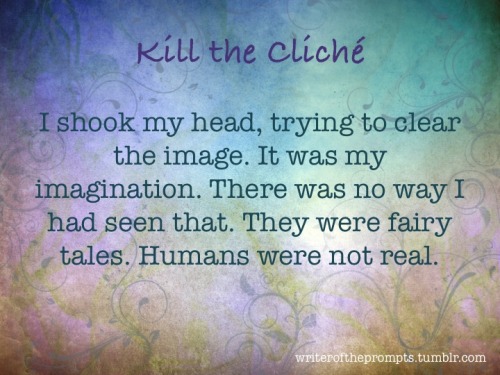#writing strategies
We all know those tired clichés. It’s time to kill them. Take one of them and turn them on their heads or at least these will hopefully keep the errors out of your writing. If you think of any other way to change them up go right ahead. Happy hunting!
I shook my head, trying to clear the image. It was my imagination. There were fairy tales. Humans were not real.
One of my favourite prompts
Post link
I find that a rise in LGBT in books, tv, movie etc to be so inspiring an outstanding. I love how people are finally getting the idea that if you want your audience to feel a connection to a character you charter has to be real. A HUGE part of real life is the LGBT community.
But I dislike when shows and books just throw LGBT characters in there with no development. It is great to see some representation but why is that character gay for like two episodes or the last thirty seconds of a movie.When I first started writing LGBT I asked people I knew what it was like and the answer was always different. The only thing all those people had in common was it took time to find that part of themselves. It is so inspiring to hear those stories and to implement them can teach your audience such important lessons about self-discovery. When That story is just thrown in I feel like something great just got thrown out.
Using said after the dialogue isn’t great and neither is just plugging in -ed or -ly words. Try adding more to help your reader better understand how the charter feels. Don’t be afraid to make it creative, make a comparison, or make it metaphorical.
“I can’t” she said.
“I can’t” she said shyly.
“I can’t” she whispered only to herself, but she didn’t realize the dust in the empty chair could hear too.
Writing a sub-plot
Here are some tips for writing great sub-plots, romantic or otherwise.
1. When to introduce a sub-plot
- Of course, every story is different. However, there is some consensus that it’s good to introduce your sub-plot a little ways into your book
- The main plot needs to be established first. The readers need to know the main character(s) and understand what the story is about. They need to care about the crux of the book and the characters first.
- Then, you can introduce an intriguing subplot to keep their interest.
- Don’t wait too long, though. Anything after 1/3 through might feel forced and misplaced.
2. When to resolve the sub-plot
- The sub-plot should be resolved before the main plot is.
- Generally, you want your readers’ attention focused on the main conflict once you reach the climax.
- This means that you want to give them the resolution of the sub-plot a few pages/chapters before the big showdown of the main plot.
- You’ll see that most TV episodes also follow this guideline and it works.
- You can, roughly, aim for the ¾ mark if you’re unsure.
3. Remember the sub in sub-plot
- I love a good sub-plot, especially one about characters growing closer. However, if I pick up a sci-fi thriller from the bookstore only to read a 400 page love story, I’m gonna be disappointed.
- You classify your genre according to your main plot. What is the main conflict or purpose in your story? That should be the focus.
- A sub-plot of whichever variation is always secondary to the main storyline.
- If you focus too much on the subplot, it may overpower your real story and bump your book into a whole other genre.
- So, maybe have the romance take a backseat when the main plot comes to play.
4. When to indulge
- Let’s be honest; we all love writing our sub-plots. They often contain the scenes you envisioned when thinking up your story - the conversations and fluff, the banter and depth of character. This, unfortunately, means that it’s easy to get carried away, as I made clear in my last point.
- However, there is a part of your book in which you can indulge, a point during which you can explore the sub-plot to your heart’s desire.
- When is that point? The middle.
- Often, the main plot slows down in the middle of the book. The characters need training or there’s a period of false security etc. Many stories have a lull in the middle where the main conflict isn’t in full swing.
- And this is where the sub-plot shines. This is where characters fall in love and heroes reunite with long-lost fathers. This is where you get to place your darling scenes.
- And no, this doesn’t mean that your middle can be 200 pages and you can write an entire romance novel. It also doesn’t mean that the main plot must disappear. It’s just a stage in the story where you can let the sub-plot loose a bit.
- Also don’t leave every aspect of your sub-plot for the middle. It should be woven into your story.
- But use the middle to let the sub-plot shine.
5. Should you have a sub-plot?
- Personally, I think every story needs some form of sub-plot.
- There has to be some conflict/story/relationship that develops and adds intrigue aside from the main plot.
- Not having one could screw up your pacing, make your characters feel underdeveloped and generally make for a boring read.
- But, this is just my opinion. Each unto their own.
That’s it. Those are some basic tips on writing a sub-plot. I hope that they could be helpful. As always, my inbox and asks are open for any questions.
Reblog if you found these tips useful. Comment with the type of sub-plot you’re writing. Follow me for similar content.

